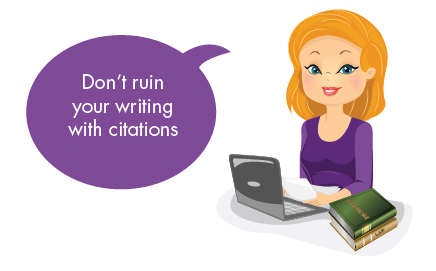 Despite the efforts of legal writing guru Bryan Garner to promote use of “citational” footnotes, placing citations in the main body of the brief or memo remains the dominant method.
Despite the efforts of legal writing guru Bryan Garner to promote use of “citational” footnotes, placing citations in the main body of the brief or memo remains the dominant method.
And so, for the most part, or at least when writing for most courts and legal practitioners, attorneys must work to minimize an in-body citation’s potential to distract the reader.
The idea is to make the citation as unobtrusive as possible, so it does not overpower the statement it supports.
Don’t start a sentence with a full citation. Doing so sends the message that the citation itself is more important than its relevance to your argument. It’s kind of like putting the emphasis on the wrong syllable. To avoid that, introduce the case first in some manner. Try stating its significance, such as the rule it supports, before trotting out the coding that shows where it can be found.
Midsentence citations are equally problematic. Their use greatly risks stanching the flow of the argument and breaking the reader’s concentration. If you must insert a citation into a sentence, keep it as short as possible. And forego including parallel and string citations.
If the beginning and the middle are out, what remains? The end, of course. And that is the best location for an in-body citation: at the end of the sentence.
The California Style Manual includes a rule of thumb for placement of (in-body) citations. Chapter four, section 66 says, “A footnote should be placed as close as possible to the text that is footnoted, provided the placement will not seriously disrupt the natural flow of the sentence.”
That makes sense.
Garner says placing the volume and page number and the abbreviated form of the reporter’s name in footnotes results in stronger writing. So, when doing in-body citations, check the coherence of your sentences and paragraphs by reading the text without them. Make sure your citations haven’t dismembered your thoughts, and that you’ve explained why and how the cited authority matters using your own words, in your own voice. If you rely exclusively on parenthetical descriptions to do that work, your arguments will lack cogency. And keep those parentheticals fairly short, just as chapter one, section six of the California Style Manual commands. “Parenthetical comments or quotes that are full sentences or multiple sentences are disfavored,” the manual notes.
Finally, try to avoid string citations altogether, not just when you have to insert one into a sentence. Only when you make a point that goes directly to the heart of your case and is likely to be disputed do you need to cite more than one governing authority.
As Garner points out in Making Your Case: The Art of Persuading Judges, what matters most is not how many cases you come up with, “but how well you use them.”
 About the author:
About the author:
Savannah Blackwell is a former news reporter who covered government and politics for more than a decade, mostly in San Francisco. She became a licensed California attorney in 2010 and specializes in legal research and writing. She can be reached at savannah.blackwell@gmail.com. Follow her on Twitter at @SavannahBinSF.


